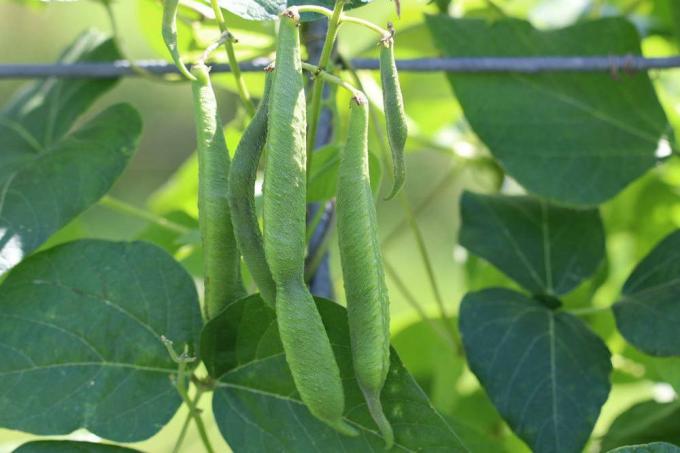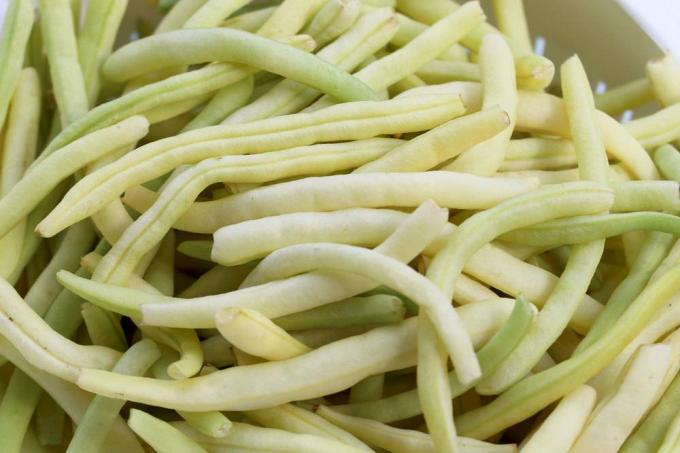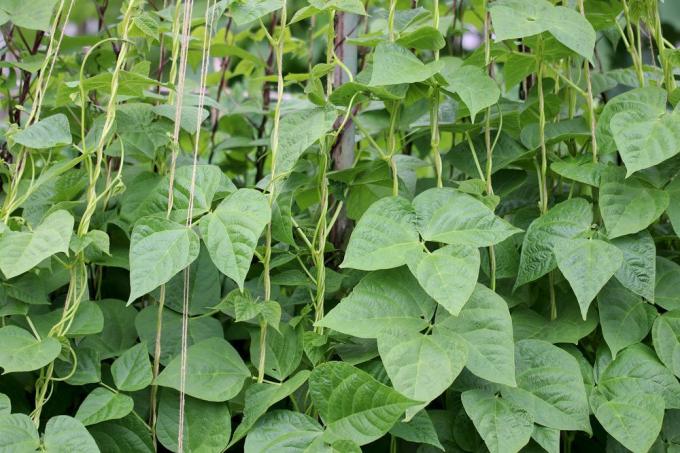
table of contents
- Classification
- According to growth characteristics
- After use
- 1. French beans
- 2. Cut beans
- use
- French beans
- Rice beans
- Runner beans
- Broad beans (Vicia faba)
Beans belong to the legume family (Fabaceae) and are divided into numerous bean genera and bean types with different properties and uses. Beans are not only the roundish, partly kidney-shaped seeds, but also the surrounding pod, including the seeds. A total of over 700 types of beans are known, and the names are often a bit confusing. In order to shed some light on the darkness, we have put together a rough overview.
Classification
According to growth characteristics
The subdivision of the bean types and varieties is often based on the growth characteristics.
1. French beans (Phaseolus vulgaris var. nanus)
Bush beans are one of the types of beans that develop self-standing bushes. They have a slightly shorter harvest period than types of beans that belong to the runner beans. Although the yield per plant of French beans is somewhat lower, they can be planted much more densely.
- Bean species and varieties with low, compact growth
- Height of these beans: 30 to 70 cm
- no climbing aid necessary
- shorter harvest period
- well suited for small kitchen gardens

2. Rice beans
The medium-high rice beans get their name from their growth habit. These types of beans need branches (raisers) that are stuck into the ground as climbing aids.
- Height: 70 to 120 cm
3. Runner beans (Phaseolus vulgaris var. vulgaris)
Runner beans are also known as climbing or climbing beans, they are considered to be very tall bean varieties. This also includes runner beans or firebeans (Phaseolus coccineus).
- climbing or trailing bean species
- Height: 2 to 3.5 m
- need trellis
After use
Depending on the type of seed and the pod, the individual types of beans are used differently.
Young pods
The young, still unripe pods of some types of beans are particularly fleshy and tender. That is why many French and runner beans are harvested as so-called "green beans" before the seeds are formed. These types of beans often contain a “thread” in the fruit pod that has to be pulled off before processing. Many new varieties are already bred without a thread and are therefore offered in stores as threadless beans. The different types are listed below.

Types
1. French beans
Green beans have round or oval, fleshy pods and very small kernels. No cutting tool is required to shred them. You can just break it.
Green beans and fillet beans
Princess beans or delicatessen beans are types of beans with short, string-free pods. They have a rounded cross-section and are particularly delicate.
- particularly slim, threadless tubes
- very early harvest (hardly any seed development)
Bean varieties:
Blauhilde
- Runner bean
- thick, round pod up to 25 cm in length
- blue-black coloring
- turns green when cooked
- Harvest time all summer

Delinel
- very high yielding variety from France
- stringless fillet broad bean
- up to 18 cm long, delicate pods
Duplicate
- medium-late broad bean
- pods up to 20 cm long
- good resistance to fungal diseases
Duplicates
- dark green, early broad bean
- stable high bush
- pods up to 18 cm long
- resistant to burn spots and bean mosaic virus
Jutta
- medium early French beans
- 13 cm long, threadless tubes
- Growth height: up to 45 cm
- good resistance to burn marks and grease marks
Maxi
- robust broad bean
- long, slender pods up to 18 cm in length
- thread free
- ripen over a long time
- Pods hang freely over the foliage
Neckar Queen
- popular runner bean
- long, straight and threadless sleeves
- juicy, thick-skinned meat
- pods over 20 cm long
- resistant to bean mosaic virus
Princess
- medium early French beans
- round, slightly curved, light green pods
- good resistance to known bean diseases
- insensitive to cold and damp locations
Purple Tepee
- blue-violet, stringless broad bean
- tender, brown-grained beans up to 15 cm in length
- turns green when cooked
- Fruits hang freely above the foliage (easy harvest)

Saxa
- Tried and tested, early broad bean variety
- fast growing
- medium-length, almost straight pods
- for a long time
- resistant to grease stains, virus tolerant
Pearl beans
The pods of pearl beans contain small, spherical seeds that protrude from the pod like a string of pearls. The kernels are also suitable for drying.
Sugar Pearl Perfection (Turkish Pea)
- very old broad bean variety
- small-seeded pearl bean with green pods
- long harvest period
Pearl bean
- traditional, north German runner bean
- green pods
- round, white grain
- ripening early
Wax beans
Wax beans are yellow-pod bean varieties that are mostly used in salads. Among the wax beans there are both runner and bush beans.
Anellina Giallo (yellow ringlet)
- Runner bean
- golden yellow pods with red, small seeds
- strongly curved sleeve
- belongs to the late bean species from Italy
Mountain gold
- threadless, yellow pods
- robust, well-tried variety
- good taste

Brittle Wax
- yellow pod with pale black speckled kernels
- very good taste
- ripe early
Gold ducat
- Broad bean
- elongated, yellow pods
- threadless
Golden Teepee
- high-yielding yellow variety
- about 14 cm long pods
- very early, easy harvest
- Pods hang over the leaves
Goldmarie
- belongs to the high-climbing bean species
- robust runner bean
- very early harvest
- fleshy
- threadless
Hildora
- long, yellow pods
- outstanding taste
- high yield
Voletta
- Enhancing the wax best of all
- 15 cm long, slender, straight yellow pods
- delicate pods with a good aroma
- highly tolerant of all bean diseases
2. Cut beans
Cut beans were one of the types of beans that are characterized by a flat, wide pod. Since the pods quickly become fibrous and coarse, they have to be harvested very early. Before preparation, these sword beans or cut beans are cut into thin strips.
Bean types:
Admires
- belongs to the bushy growing bean species
- early, very productive variety
- long, tender beans without a string
Algarve
- Runner bean
- richly bearing variety with strong growth
- thread-free pods up to 28 cm in length
- very tender even when harvested later
Lady Di
- Runner bean with fiery red flowers
- fleshy, stringless pods up to 30 cm in length
- very tender
- long harvest time
- resistant to disease

Limka
- Runner bean
- belongs to types of beans with very long pods
- good quality and taste
White giants
- Runner bean (runner bean)
- white blooming
- high and fast climbing
- flat, fleshy pods (30 cm long)
- aromatic taste
use
Using the bean seeds / dry beans
With the so-called Pal or dried beans, the pods are rather thin and hard. That is why they are usually not used in the kitchen. When the grain ripens completely, it becomes firm and very hard. In this case, the beans can be stored in a dry place. Theoretically, it is possible to let all types of beans mature into dry beans. Usually, however, it is the varieties with particularly large seeds that form the typical Pals varieties.
French beans
Aramis
- tender, green fillet bean
- narrow, rod-shaped kernels
- blue-violet speckled, basic color light brown
Barbunya
- old Turkish broad bean
- large, oval beans
- cream-colored with wine-red grain
- slightly sweet taste
Black Turtle
- classic black bean from Mexican cuisine
- Broad bean
- smaller, black seeds
- green pods can also be eaten young
Borlotto (rosso)
- classic Italian broad bean
- red-brown kernels
- red and white speckled pods, 12 cm long
- old types of this variety: Regina (Chioto)

Brown Dutch
- historical variety from Holland
- brown beans
- particularly aromatic and fine-grained
- pods up to 12 cm long
Canadian Wonder
- one of the most popular types of beans
- typical kidney bean (Indian bean)
- excellent taste
Cannelino
- is one of the popular types of beans from Italy
- also called white kidney bean
- flat oval, white bean seeds
- 10-15 mm length
Black dalmatians
- kidney-shaped, large nuclei
- black and white bean variety
- early variety with high yield
Rice beans
Bamberg Blue
- old local variety from Bavaria (1860)
- beautiful, blue speckled kernels
- beige base color
- large cores
- Height: about 1 m
- purple flowers
Cherokee Trail of Tears
- black rice bean
- historical variety of Cherokee Indians
- shiny, small seeds
- threadless pods, turn purple when ripe

Purple Prince
- almost the entire plant purple
- The cores have a purple-white pattern
- deep purple pods
- young pods are very tender
- very early variety
Tarahumara Bakamina
- is one of the popular types of beans from South America
- shiny, wine-red beans
- fine black ring around the navel
- dried beans have a fleshy texture
White pearl
- small white beans
- creamy texture
- short, green pods
- well suited as balcony vegetables in the bucket
Runner beans
Borlotto Lungua di Ruoco
- is one of the most popular types of beans
- salmon-pink grains with wine-red stripes
- fiery red pods with a yellow base color
Floreta
- visually appealing variety from Spain
- Grains: basic white color
- speckled around the navel in all sorts of shades of brown
- buttery and beany taste
Trout bean
- Can be used young as a green bean
- spectacular, purple speckled kernels
- carries late and plentiful

Herrenböhnli
- Gourmet bean from Switzerland
- round oval, pale pink to pink-brown seeds
- shine like pearls
- Lots of green, short pods
Monastery women
- can be used as legume and dry beans
- two-tone bean kernels (white and wine red)
- red drawing around the navel
- old variety from Switzerland
Large cannelini
- Italian variety
- large, pure white bean kernels
- green pods
Poleshka
- very high yielding variety
- shiny, dark purple kernels
- stand out through the yellowish shell
Red Lapwing Bean
- Can be used young as green beans
- Grains: beige base color with burgundy stripes
- green pods, almost completely red as they ripen
Sietske
- historical bean variety from the far north
- straw yellow grains
- Can be used young as a green bean
French beans
- one of the old types of beans
- medium-sized, beige bean with a dark pattern
- large, red speckled pods
- becomes ripe even in bad locations

Broad beans (Vicia faba)
Broad beans are also known as broad beans or broad beans. Just like their relatives, the French and runner beans, broad beans belong to the butterfly family, albeit to the genus of the vetch
When harvested young, the pods of the broad beans can also be eaten. Usually, however, the milk-ripe or mature beans are used.
Triple whites
- early, popular variety
- white flowers and white pips, stay white when cooked
- very tender and good in taste
- medium to tall growing
- strong taste
Hangdown green core
- proven variety that ripens early
- tender, green seeds, turn brown when cooked
- dark green pods
- Height: about 80 cm
Hunsrück
- belongs to the late bean species
- very large, beige-colored grains
- medium high variety
- yellow to beige pips
Listra
- early broad bean
- green-white kernels
- very tender and tasty
- robust against cold weather
Osnabrück market
- belongs to the medium-early bean varieties
- hanging pods
- tried and tested
- very light core, darkens when cooked

Piccola
- belonged to the late bean varieties
- steadfast
- tolerant of most fungal diseases
- green kernels
Witkiem (early white germs)
- early variety
- long, thick pods
- white beans with a mild taste
- resistant to bad weather



